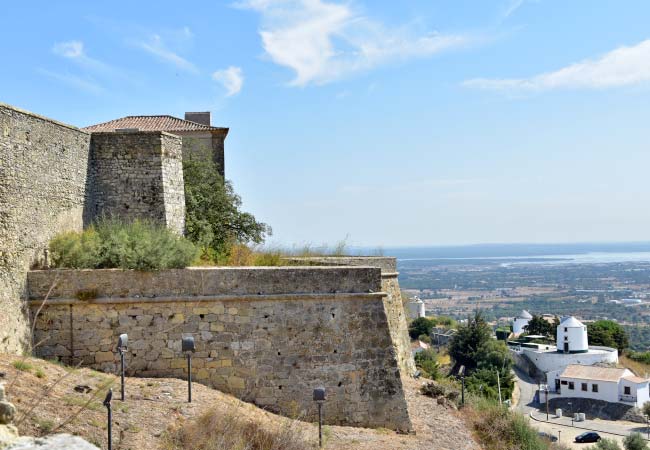Algarve-Tourist.com
The best independent guide to the Algarve
Algarve-Tourist.com
The best independent guide to the Algarve
Lisbon to Algarve: Best Stops Along the A2 and Coastal Routes - 2025 Guide
The drive between Lisbon and the Algarve is one of the most common road routes taken by tourists in Portugal.
For most visitors, the journey follows the A2 motorway, Portugal's main north-south artery. While undeniably the fastest option at just 2.5 hours non-stop to Albufeira from Lisbon, this route cuts through the arid interior of the Alentejo region, where interesting stops are surprisingly scarce.
The reality is that the A2 offers limited appeal for those hoping to explore. The motorway bypasses most towns of interest, with the best destinations clustered near either end of your journey. Close to Lisbon, the coastal towns of Setúbal and Sesimbra reward short detours, while in the Algarve, the market town of Loulé and the historic town of Silves provide genuine Portuguese character away from the beach resorts.
For those determined to break the A2 journey midway, Alcácer do Sal stands out as possibly the best option, though even this historic salt-trading town merits only an hour's visit. The major towns of the interior Alentejo, including Beja and Odemira, each require a 40-minute detour from the A2 and will make the drive considerably longer.
For those with time to spare, the western coastal route transforms a simple journey into a scenic adventure. This alternative route follows the wild Atlantic coastline through charming fishing villages and dramatic coastal landscapes. Vila Nova de Milfontes and Porto Covo provide options to spend the night, while the industrial port of Sines offers historical interest as Vasco da Gama's birthplace.
The coastal route takes considerably longer if you plan to do it in one day. Simply including Vila Nova de Milfontes will add over one hour of driving time, but patient travellers will be rewarded with some of Portugal's most dramatic coastal scenery.
This guide covers both routes in detail: the direct A2 motorway for efficient travel and the scenic coastal alternative for those seeking a more memorable journey.
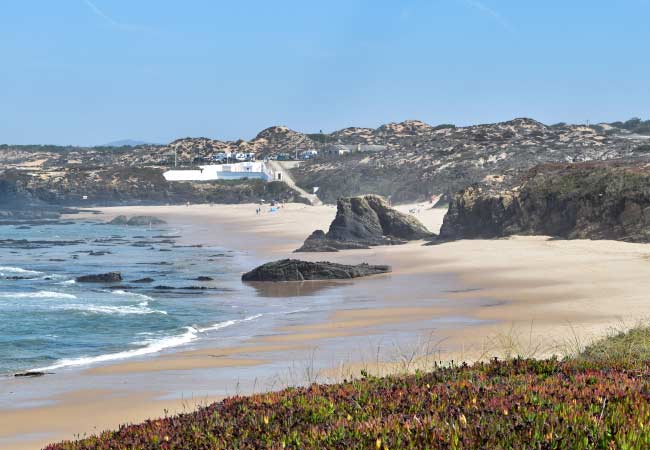
The stunning beaches of the Alentejo coastline near Vila Nova de Milfontes
Map
Below is an interactive map of the route from Lisbon to the Algarve along with the recommended stop and service stations. The map also marks the A22 expressway in the Algarve and the A12 into Lisbon, which is the recommended route
Legend 1) Alcácer do Sal 2) Beja 3) Odemira 4) Vila Nova de Milfontes 5) Porto Covo 6) Sines 7) Setúbal 8) Sesimbra 9) Palmela 10) Silves 11) Loulé
Service stations: 12) Palmela 13) Alcácer do Sal 14) Grândola 15) Aljustrel 16) Almodôvar
The A2 Motorway Route: Quick Stops and Hidden Detours
The A2 motorway provides the fastest connection between Lisbon and the Algarve, but don't expect scenic variety along this 240km stretch of highway. The route cuts through the Alentejo's vast cork forests and rolling agricultural plains, landscapes that become monotonous after the first hour.
Alcácer do Sal (90km from Lisbon, 150km to Faro)
Alcácer do Sal is the only town along the A2 truly worth leaving the motorway for. This ancient settlement overlooks the Sado River from its hilltop position, with a castle that has watched over the salt trade since Roman times.
Exit at junction 9 and the town is just 5 minutes from the motorway. The castle ruins offer pleasant views over the river plains, while the narrow streets below contain a handful of cafés and restaurants. The town's signature sight is the cripta arqueológica, a Roman ruin discovered beneath the town hall.
For lunch, Pousada Castelo Alcácer do Sal occupies the converted castle with terrace views, though prices reflect the prestigious location. More affordable is O Paço near the main square, serving reliable Alentejo dishes.
Realistically, Alcácer do Sal merits an hour's stop at most. The castle walk takes 20 minutes, leaving time for coffee or a quick meal. It's a pleasant break but not a destination in itself.
Beja (165km from Lisbon, 105km to Faro)
Beja requires a 40-minute detour east from the A2 (exit at Castro Verde), immediately raising the question: is it worth the extra 80 minutes of driving? For most travellers heading to the beach, the answer is no.
This regional capital offers an imposing 13th-century castle (now a military museum), a historic center with traditional architecture, and the Museu Regional housed in a former convent. The town maintains authentic Portuguese character precisely because it sees few tourists.
If you do detour, park near the castle and explore the compact historic center on foot. Casa de Pasto Charrua serves hearty Alentejo specialties at local prices. Allow 2 hours minimum to justify the detour.
Odemira (185km from Lisbon, 115km to Faro)
Odemira sits 40 minutes west of the A2 via the N263, making it an even less practical stop than Beja. The town spreads along the Mira River with whitewashed buildings climbing the hillsides, creating an attractive setting that photographs well.
The historic center preserves traditional Alentejo architecture, and the riverside provides a pleasant stroll. However, there's little to actually do here beyond admiring the views and grabbing a meal. Unless you're specifically interested in rural Portuguese life or need an overnight stop, the detour doesn't justify the time.
Service Stations: Your Realistic Stops
For most travellers, the A2's service stations provide the most practical break options:
Palmela Service Area (30km south of Lisbon) - The best early stop with a proper restaurant, clean facilities, and even a small playground. Galp fuel station with reasonable motorway prices. Good for a proper meal after navigating Lisbon's outskirts.
Alcácer do Sal Service Area (90km from Lisbon) - Modern Galp station with Colibri restaurant serving decent hot meals and local products. More appealing than the typical motorway café, though Alcácer do Sal town is just 5 minutes away for better dining options.
Grândola Service Area (115km from Lisbon) - Well-positioned for a midway break. Repsol fuel and another Colibri restaurant, plus picnic area. Often busy during peak summer travel.
Aljustrel Service Area (180km from Lisbon) - The final major stop before the Algarve. Galp station with Colibri restaurant and children's facilities. Well-maintained and sufficient for a quick break.
Almodôvar Service Area (220km from Lisbon) - Last stop before the A2 merges with the Algarve's A22. Cepsa fuel and Colibri restaurant. Most travellers push through rather than stopping this close to their destination, but useful if you need that final break.
Entering Lisbon: Avoiding Bridge Traffic
When heading north into Lisbon, the A2 naturally funnels traffic toward the Ponte 25 de Abril bridge. This iconic suspension bridge serves as a major bottleneck, particularly on Sunday afternoons and evenings when beachgoers return from the Algarve.
The congestion can be severe, what should be a 10-minute crossing often stretches to 45 minutes or more. Summer Sundays see the worst delays, typically starting around 3pm and lasting until 9pm. Even weekday evenings experience significant slowdowns during rush hour.
The toll plaza before the bridge (€1.90 for cars heading north) only compounds the delays. While the bridge offers spectacular views of Lisbon's waterfront and the Cristo Rei statue, sitting in gridlocked traffic quickly diminishes any sightseeing appeal.
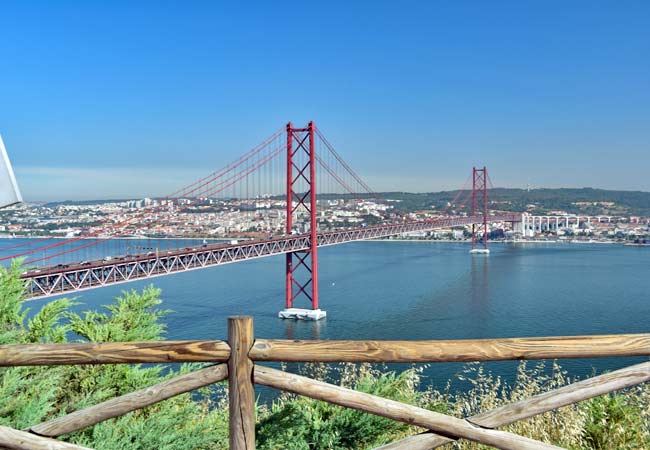
The Ponte 25 de Abril does make a spectacular way to enter Lisbon
The Vasco da Gama Alternative
The smarter option is to divert to the Vasco da Gama bridge via the A12. From the A2, take the junction toward Setúbal/A12, then follow signs for the Vasco da Gama bridge. This route adds approximately 15km to your journey but often proves faster during peak times.
The Vasco da Gama bridge rarely experiences significant congestion, even during busy periods. The 17km crossing, Europe's longest bridge, maintains steady traffic flow with multiple lanes in each direction. The €2.85 toll feels justified when you sail past while Ponte 25 de Abril traffic sits stationary.
This eastern approach also provides better access to Lisbon's airport and the Parque das Nações district, making it ideal if your accommodation lies in eastern Lisbon. For destinations in central or western Lisbon, you'll need to navigate the city's ring roads, but you'll still likely save time during peak periods.
The Coastal Route: Portugal's Hidden Riviera
The western coastal route transforms a mundane motorway journey into a proper road trip. This alternative follows the N120 and N390 along the Atlantic, trading speed for spectacular ocean views and authentic Portuguese coastal life. Be warned: this isn't a quick detour, it's a completely different journey requiring at least an extra 90 minutes of driving time.
Vila Nova de Milfontes (165km from Lisbon)
Vila Nova de Milfontes justifies the coastal route almost single-handedly. This fishing town sits where the Mira River meets the Atlantic, creating a double blessing of calm river beaches and wild ocean shores, all within the protected Southwest Alentejo and Vicentine Coast Natural Park.
The historic center clusters around the small castle fortress, with narrow streets leading down to the riverside promenade. Unlike many coastal towns, Vila Nova de Milfontes maintains its Portuguese character, helped by strict building regulations of the Parque Natural do Sudoeste Alentejano e Costa Vicentina.
The town's unique position between river and ocean provides beaches for every preference. Praia da Franquia, sheltered within the river estuary, offers calm, warm waters ideal for families with young children.
For those seeking Atlantic drama, Praia do Malhão (3km north) delivers spectacular scenery with golden cliffs and powerful waves. The wild beauty here epitomizes the Alentejo coast, vast stretches of sand, scattered rock formations, and hardly a building in sight.
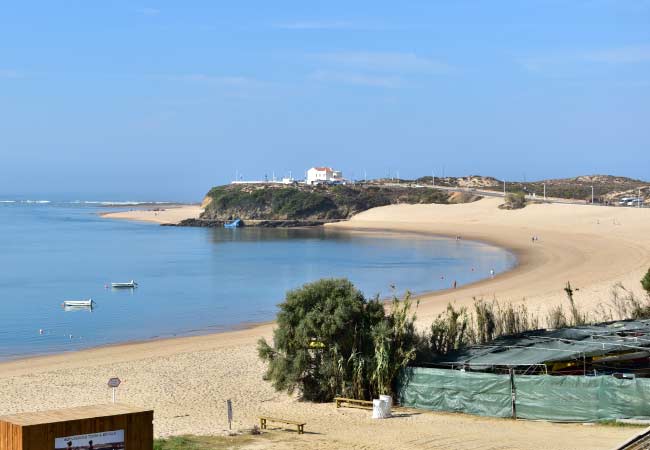
Porto Covo (15km north of Vila Nova de Milfontes)
This tiny fishing village makes an ideal lunch stop without the overnight commitment. The entire historic center spans just a few streets of single-story whitewashed houses, maintaining the charm that development destroyed elsewhere.
The main draw is its location, sitting on low cliffs with wooden walkways leading to a series of perfect cove beaches. Praia Grande lives up to its name with a long sandy stretch, while the smaller coves offer shelter from the persistent north wind.
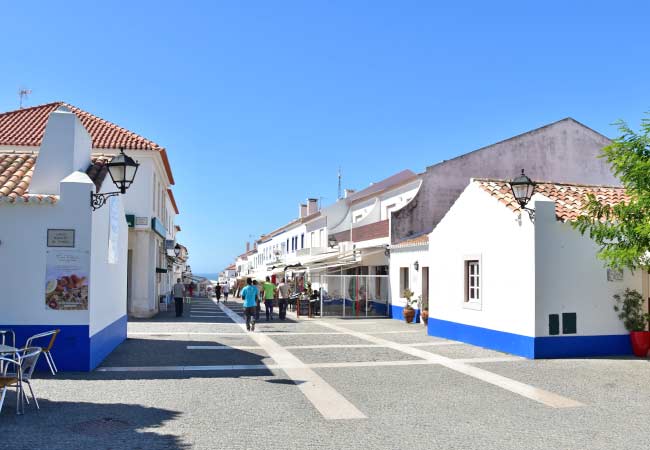
Sines (170km from Lisbon)
Sines presents a dilemma. As Vasco da Gama's birthplace, it holds genuine historical significance. As a major industrial port and oil refinery center, it's decidedly unscenic. The massive petrochemical complex dominates the southern approach, while container ships crowd the horizon.
The compact historic center tries hard, with a rebuilt castle housing a museum dedicated to its famous son. The clifftop location offers decent views if you can ignore the industrial backdrop. The town beach, Praia Vasco da Gama, is surprisingly good given the setting.
For most travellers, Sines works only as a quick coffee stop or for those with specific interest in Age of Discoveries history. The castle museum takes 30 minutes, leaving time to walk the compact center.
Stops Near Lisbon (first/last hour of the journey)
These destinations lie within 50km of Lisbon, making them viable stops whether you're taking the A2 or coastal route. Each requires a detour from the main road, so choose based on your interests and available time.
Setúbal (50km from Lisbon, 30-minute detour from A2)
Setúbal deserves more recognition than it gets. This working port city may lack resort prettiness, but it compensates with authentic character, excellent seafood markets, and surprising natural beauty in the nearby Arrábida Natural Park.
The city center focuses on the Praça de Bocage and surrounding pedestrian streets. The 15th-century Igreja de Jesus showcases early Manueline architecture, while the nearby Mercado do Livramento ranks among Portugal's best fish markets. Arrive before noon to see the full spectacle of the morning catch - everything from massive tuna to tiny percebes.
The real draw lies across the Sado estuary: a resident pod of bottlenose dolphins. Boat trips depart from the marina with near-guaranteed sightings. The 3-hour tours (around €35) include commentary about the estuary's ecosystem.
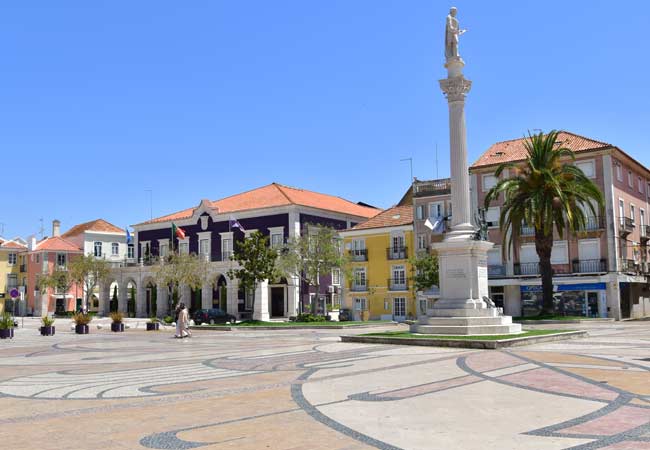
Sesimbra (40km from Lisbon, 45-minute detour from A2)
Sesimbra pulls off a difficult balance: a proper fishing town that welcomes tourists without losing its soul. The setting helps, a perfect crescent beach bookended by the hillside castle and the harbour where colourful fishing boats still land their catch.
The Moorish castle perches 200 meters above town, accessible via a steep but well-maintained road. The views justify the climb, stretching from the Arrábida mountains to Cabo Espichel. The castle itself is free to enter, with walls you can walk and a small church within. Morning visits avoid both crowds and heat.
Below, the town beach stretches for nearly 2km with Blue Flag status and calm waters protected by the bay. Even in summer, the beach rarely feels overcrowded thanks to its length. The eastern end near the fishing port offers the best atmosphere, with locals playing cards in waterfront cafés while nets dry in the sun.
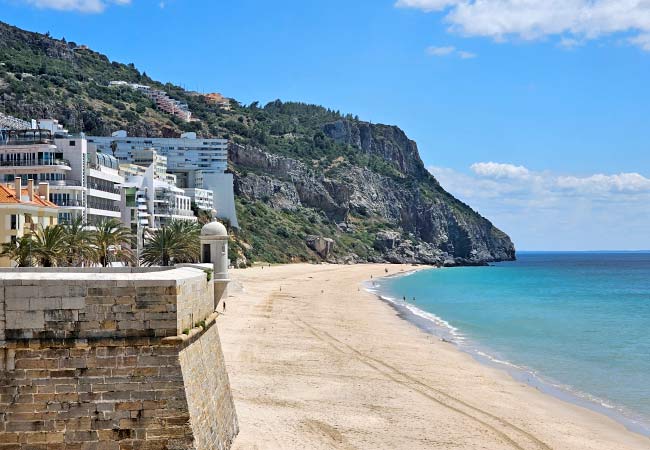
Palmela (40km from Lisbon, 15-minute detour from A2)
Palmela's castle dominates the landscape from its strategic hilltop, visible for miles around. This isn't just another ruined fortress, the 12th-century castle now houses a luxury pousada, though the grounds remain open to visitors.
The views alone justify the detour. On clear days, you can see Lisbon's skyline to the north, the Atlantic to the west, and the Alentejo plains stretching south. The castle terraces provide a 360-degree panorama that helps you understand the geography of your entire journey.
The small historic town below the castle preserves its medieval layout with narrow streets barely wide enough for cars. Park near the main square and walk up to the castle - it's steep but takes only 15 minutes. The Igreja de São Pedro contains impressive 18th-century azulejos if you appreciate tilework.
